Explains the mathematics, theory, and methods of Big Data as applied to finance and investing Data science has fundamentally changed Wall Street—applied mathematics and software code are increasingly driving finance and investment-decision tools. Big Data Science in Finance examines the mathematics, theory, and practical use of the revolutionary techniques that are transforming the industry. Designed for mathematically-advanced students and discerning financial practitioners alike, this energizing book presents new, cutting-edge content based on world-class research taught in the leading Financial Mathematics and Engineering programs in the world. Marco Avellaneda, a leader in quantitative finance, and quantitative methodology author Irene Aldridge help readers harness the power of Big Data. Comprehensive in scope, this book offers in-depth instruction on how to separate signal from noise, how to deal with missing data values, and how to utilize Big Data techniques in decision-making. Key topics include data clustering, data storage optimization, Big Data dynamics, Monte Carlo methods and their applications in Big Data analysis, and more. This valuable book: Big Data Science in Finance: Mathematics and Applications is an important, up-to-date resource for students in economics, econometrics, finance, applied mathematics, industrial engineering, and business courses, and for investment managers, quantitative traders, risk and portfolio managers, and other financial practitioners.
Table of Contents
- Cover
- Title Page
- Copyright
- Preface
- Chapter 1: Why Big Data?
- Chapter 2: Neural Networks in Finance
- Introduction
- Neural Network Construction Methodology
- The Architecture of Neural Networks
- Choosing the Activation Function
- Construction and Training of Neural Networks
- Model Selection via Dropout
- Overfitting
- Adding Complexity
- Big Data in Machine Learning
- Coding a Simple Neural Network for One Instrument from Daily Data
- Defining Target Outputs
- Testing Performance
- Adding Activation Levels
- Convergence
- Choosing Input Variables
- Conclusion
- Appendix 2.A Building a Neural Network in Python
- References
- Chapter 3: Supervised Learning
- Chapter 4: Modeling Human Behavior with Semi-Supervised Learning
- Chapter 5: Letting the Data Speak with Unsupervised Learning
- Chapter 6: Big Data Factor Models
- Why PCA and SVD Deliver Optimal Factorization
- Eigenportfolios
- Using Factors to Predict Returns
- Factor Discovery
- Instrumented PCA
- The Three-Pass Model
- Risk-Premium PCA
- Nonlinear Factorization
- Correlation-Based Factors
- Hierarchical PCA (HPCA)
- Disadvantages of PCA and SVD
- Conclusion
- Appendix 6.A Python for Big Data Factor Models
- References
- Note
- Chapter 7: Data as a Signal versus Noise
- Introduction
- Random Data Shows in Eigenvalue Distribution
- Application: What's in the Data Bag?
- The Marčenko-Pastur Theorem
- Spike Model: Which Value to Pick on the “Elbow”?
- Dealing with Highly Correlated Data
- Deconstructing the Mona Lisa
- What's in the Data Bag?
- Applications
- The Karhunen-Loève Transform
- Data Imputation
- Missing Eigenvalues
- The Tracy-Widom Distribution
- Identifying (and Replacing) Missing Values in Streaming Data (the Johnson-Lindenstrauss Lemma)
- Conclusion
- Appendix 7 Finding the Optimal Number of Eigenvectors in Python
- References
- Chapter 8: Applications: Unsupervised Learning in Option Pricing and Stochastic Modeling
- Chapter 9: Data Clustering
- Conclusion
- Index
- End User License Agreement
